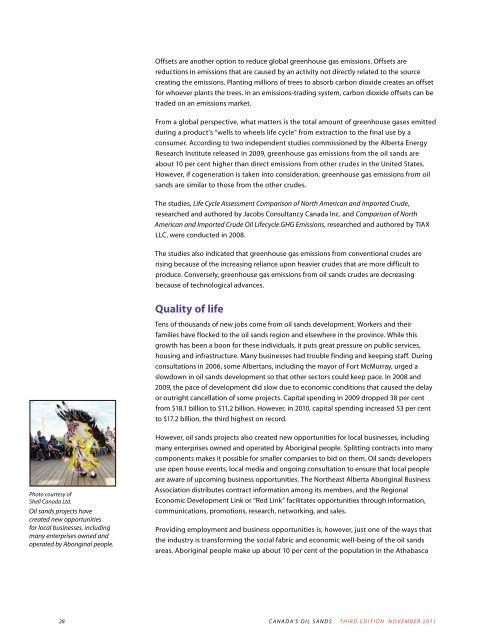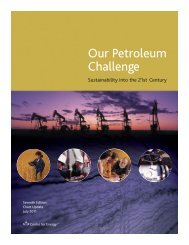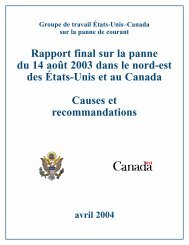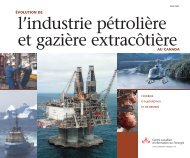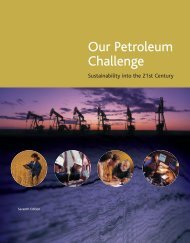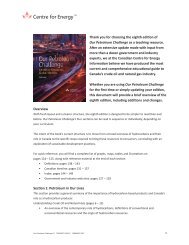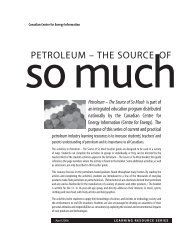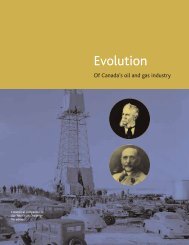Canada's Oil Sands - Centre for Energy
Canada's Oil Sands - Centre for Energy
Canada's Oil Sands - Centre for Energy
Create successful ePaper yourself
Turn your PDF publications into a flip-book with our unique Google optimized e-Paper software.
Offsets are another option to reduce global greenhouse gas emissions. Offsets are<br />
reductions in emissions that are caused by an activity not directly related to the source<br />
creating the emissions. Planting millions of trees to absorb carbon dioxide creates an offset<br />
<strong>for</strong> whoever plants the trees. In an emissions-trading system, carbon dioxide offsets can be<br />
traded on an emissions market.<br />
From a global perspective, what matters is the total amount of greenhouse gases emitted<br />
during a product’s “wells to wheels life cycle” from extraction to the final use by a<br />
consumer. According to two independent studies commissioned by the Alberta <strong>Energy</strong><br />
Research Institute released in 2009, greenhouse gas emissions from the oil sands are<br />
about 10 per cent higher than direct emissions from other crudes in the United States.<br />
However, if cogeneration is taken into consideration, greenhouse gas emissions from oil<br />
sands are similar to those from the other crudes.<br />
The studies, Life Cycle Assessment Comparison of North American and Imported Crude,<br />
researched and authored by Jacobs Consultancy Canada Inc. and Comparison of North<br />
American and Imported Crude <strong>Oil</strong> Lifecycle GHG Emissions, researched and authored by TIAX<br />
LLC, were conducted in 2008.<br />
The studies also indicated that greenhouse gas emissions from conventional crudes are<br />
rising because of the increasing reliance upon heavier crudes that are more difficult to<br />
produce. Conversely, greenhouse gas emissions from oil sands crudes are decreasing<br />
because of technological advances.<br />
Quality of life<br />
Tens of thousands of new jobs come from oil sands development. Workers and their<br />
families have flocked to the oil sands region and elsewhere in the province. While this<br />
growth has been a boon <strong>for</strong> these individuals, it puts great pressure on public services,<br />
housing and infrastructure. Many businesses had trouble finding and keeping staff. During<br />
consultations in 2006, some Albertans, including the mayor of Fort McMurray, urged a<br />
slowdown in oil sands development so that other sectors could keep pace. In 2008 and<br />
2009, the pace of development did slow due to economic conditions that caused the delay<br />
or outright cancellation of some projects. Capital spending in 2009 dropped 38 per cent<br />
from $18.1 billion to $11.2 billion. However, in 2010, capital spending increased 53 per cent<br />
to $17.2 billion, the third highest on record.<br />
Photo courtesy of<br />
Shell Canada Ltd.<br />
<strong>Oil</strong> sands projects have<br />
created new opportunities<br />
<strong>for</strong> local businesses, including<br />
many enterprises owned and<br />
operated by Aboriginal people.<br />
However, oil sands projects also created new opportunities <strong>for</strong> local businesses, including<br />
many enterprises owned and operated by Aboriginal people. Splitting contracts into many<br />
components makes it possible <strong>for</strong> smaller companies to bid on them. <strong>Oil</strong> sands developers<br />
use open house events, local media and ongoing consultation to ensure that local people<br />
are aware of upcoming business opportunities. The Northeast Alberta Aboriginal Business<br />
Association distributes contract in<strong>for</strong>mation among its members, and the Regional<br />
Economic Development Link or “Red Link” facilitates opportunities through in<strong>for</strong>mation,<br />
communications, promotions, research, networking, and sales.<br />
Providing employment and business opportunities is, however, just one of the ways that<br />
the industry is trans<strong>for</strong>ming the social fabric and economic well-being of the oil sands<br />
areas. Aboriginal people make up about 10 per cent of the population in the Athabasca<br />
28 CANADA’S OIL SANDS THIRD edition November 2011


